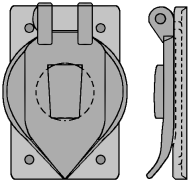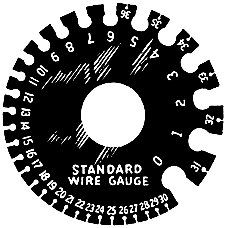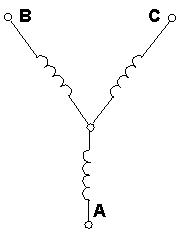Engineering Definitions
"A"
"B"
"C",
"D",
"E",
"F",
"G",
"H",
"I",
"J",
"K",
"L",
"M",
"N",
"O",
"P",
"Q",
"R",
"S",
"T",
"U",
"V",
"W",
"X",
"Y",
"Z"
'Wa' to 'Wd' 'We' to 'Wz'
Weak Pullup. A resistor or some other component that pulls a line high by being tied to Vcc, but only functions as a pull-up when the net is un-loaded. A weak pullup may be a passive component or an active component, as in a FET or transistor.
Wear Leveling. A process used in Flash memory to selectively use different segments of memory to even out the amount of accessing the same memory elements leading to early cell failure.
Wear-Out. The third and final phase of the lifetime of a population of
components when failures occur due to wear out.
Webers Theory. A theory of magnetism which assumes that all magnetic material is composed of
many tiny magnets. A piece of magnetic material that is magnetized has all of the tiny magnets aligned
so that the north pole of each magnet points in one direction.
Weatherproof: So constructed or protected that exposure to the weather will not interfere with
successful operation. Rain-proof, rain-tight, or water-tight equipment can fulfill the requirements for
weatherproof where varying weather conditions other than wetness, such as snow, ice, dust, or
temperature extremes, are not a factor.
Weighted Noise Level. A noise level weighted or adjusted with the 70dB loudness contour of normal hearing.
Wheatstone Bridge. An ac bridge circuit used to measure unknown values of resistance, inductance, or capacitance. The resistor labeled Rx in the diagram is the component to be measured. A bridge with four elements; resistors Ra, Rb and Rs are known values. When the ratio of Ra & Rb equals Rs & Rx, current is zero and Rx can be determined. Voltage [not shown] is applied to circuit nodes Ra/Rx & Rb/Rs. |
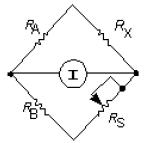 Wheatstone |
Whip Antenna. A vertical monopole. See the Antenna Dictionary.
White Noise. Noise having a frequency spectrum that is continuous and uniform over a specified frequency band. |
 White Noise |
Wide-Band. Referring to a frequency range of about 48,000Hz.
Wide-Band Amplifier. An amplifier designed to pass an extremely wide band of frequencies, such
as a video amplifier.
Wien-Bridge Oscillator. A type of oscillator that generates a sine-wave. The example to the right shows a Wien-Bridge Oscillator using a lamp as negative feedback. Also refer to the description of a Sine Wave Oscillator Circuit, which includes another schematic.
Window Comparator. A circuit that detects when a voltage is outside a voltage window, formed by a upper and lower voltage reference. Refer to a Op Amp Window Comparator circuit.
Wire. An insulated or un-insulated conductor, with low resistance to current flow, that is either solid or stranded. See a table of Wire Manufacturers. A single metallic conductor of solid, stranded, or tinsel construction, designed to carry electrical current in a circuit. It may be bare or insulated. It may have a metallic covering, sheath or shield. There may be an additional jacket for mechanical strength only; not to be used as an additional conductor.
Wire Bond. A wire for connecting the semiconductor Die to the Lead frame which forms part of the package terminal. Wire-Bond Failures by Temperature. |
3-Terminal WireBond Semiconductor |
Wire Braid. Flexible wire constructed of small size strands in tubular form. Used for shielding or connections where constant flexing is required. A wire braid may also be used as a Drain Wire. Read more on Wire Braid. Also refer to a Wire Braid Armor. An item formed by crossing three or more electrical conductors diagonally in such a manner that each conductor passes alternately over and under one or more of the others.
Wire Bundle. Two or more wires bundled or grouped together to form a cable or group of wires. In this example the wire are twisted together, but they don't have to be. The un-insulated wire would be used as a ground wire. |
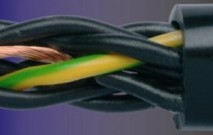 Cable Wire Bundle |
Wire Crimp. See Crimp.
Wired-AND. A circuit configuration where the outputs of two or more Open Collector active-high ICs are connected together which produces a logical AND of the outputs. | 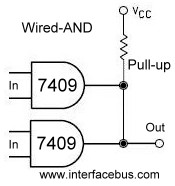 Wired-AND Circuit |
Wire Fusing. Also called Fusing Current. The point at which wire melts, due to high current. Read more from the Fusing Current Table.
Wire Gauge. A numbering system used to indicate the diameter of a wire. Wire gauge or diameter change depending on the material the wire is made of. See a graphic on the right side-bar. Refer to American Wire Gauge.
Wireless. A radio.
Wire Nut. A twist-on connector used to secure two wires together. The twist-on wire nut usually has plastic body with a threaded internal structure, but in some cases may have a metal insert to act a threads. |  |
Wire Splice. A mechanical and electrical connection between two wires. Also see Line-man Splice [with a graphic].
Wire Stripper. A tool used to strip or remove the insulation of the end of a wire.
Wireways. A cable tray.
Wire Wrap Board. A circuit board containing a number of wire wrap pins used both to mount IC or components into the female end of the pin and to attach [wrap] wires on to the male end of the terminals on the reverse side of the board. Read more on Wire Wrap Board
Wire Wrap Terminal. An elongate terminal used to accept one or more warps of wire. Refer to Minimum Wire Wrap Length graphic for a detailed diagram.
Wire Wrapping. A method of attaching a wire between components with out using traces on a Printed Wiring Board [PWB]. The components are placed in a socket or pin which have a wire wrap terminal, while the board it self is blank with either holes or plated-through holes to accept the pins. The components are then interconnected by twisting wires around the wire wrap pins attached to the components. |
 Wire Wrap Terminal |
Wirewound. A construction style used in making high power resistors. See Wirewound Resistor [Resistor Dictionary].
Wiring Diagram. A diagram that shows the connections of an equipment or its component devices or
parts. It may cover internal or external connections, or both, and contains such detail as is needed to
make or trace connections that are involved. Similar to or identical to a schematic diagram.
Wiring Harness. An item consisting of two or more individually insulated conductors (solid, stranded, or tinsel) of a definite length, with or without shielding, held together by lacing cord, metal bands, or similar type binding. Read more on Wiring Harness.
Wobble Frequency. The frequency at which an electron wobbles on its axis under the influence of
an external magnetic field of a given strength.
Woofer. A speaker designed to operate in the low frequency ranges, producing sound normally between 20Hz and 500Hz.
Word. A string of bits whose length varies depending on the system; as 32, 48 or 64 bit words.
Work. The product of force and motion.
Working Voltage. A operating voltage rating less than the break-down voltage of the material or insulator. The maximum voltage that a capacitor may operate at without the risk of
damage. [Dictionary of Capacitors].
Worst Case. A design consideration that assumes all the parameters or tolerances of a circuit are all at one end of their maximum value which would cause the circuit to behave in worst case condition. A condition when the maximum stress is applied to a component or system.
WOW. A type of distortion found in analog recoding and play-back systems caused by the variation in speed of a component such as a turntable or tape deck. A slow variation in pitch. A low frequency variation in pitch, normally under 10Hz.
WYE (Y). A 3-phase connection [source or load] in which one end of each phase winding is connected to a common point.
Each free end is connected to a separate phase wire. The diagram of this connection often resembles the
letter Y.
